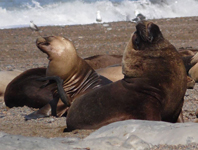Abstract
Thespidae is the most diverse family among the Neotropical Mantodea, currently containing 33 genera and 146 species of praying mantises (Wieland & Svenson, 2018). Miobantia Giglio-Tos, 1917 are small, dark coloured mantids, often found in low vegetation of humid forests near the South American Atlantic coast, from the Brazilian Northeast to the Argentine Patagonia (Scherrer, 2014). Males are active fliers, while females, apterous, are often found in leaf litter or in plants close to the ground (Scherrer, 2014; Santos et al., 2018). Despite their commonness in the Brazilian Atlantic Forest the genus received little taxonomic attention, yet had a complicated nomenclatural history. Scherrer (2014) provided a comprehensive taxonomic and nomenclatural revision of Miobantia after incorporating both molecular and morphological data to reorganize the group, resulting in the description of four new species, detailed identification keys, illustrations, association of conspecific sexes, and maps for all known species. The most recent contribution to the taxonomy of the genus was the addition of Metathespis precaria Piza, 1968 as a junior synonym of Miobantia rustica (Fabricius, 1781) (Agudelo & Rivera, 2015).
References
Agudelo, A.A. & Rivera, J. (2015) Some taxonomic and nomenclatural changes in American Mantodea (Insecta, Dictyoptera)—part I. Zootaxa, 3936 (3), 335–356.
https://doi.org/10.11646/zootaxa.3936.3.2
Brannoch, S.K., Wieland, F., Rivera, J., Klass, K.D., Béthoux, O. & Svenson, G.J. (2017) Manual of praying mantis morphology, nomenclature, and practices (Insecta, Mantodea). ZooKeys, 696, 1–100.
https://doi.org/10.3897/zookeys.696.12542
La Greca, M. (1954) Sulla struttura morfologica dell'apparato copulatore dei Mantoidei. Annali dell'Instituto Superiore di Scienze e Lettere “S. Chiara” di Napoli, 4, 1–28.
Rivera, J. & Svenson, G.J. (2016) The Neotropical ‘polymorphic earless praying mantises’—Part I: molecular phylogeny and revised higher‐level systematics (Insecta: Mantodea, Acanthopoidea). Systematic Entomology, 41, 607–649.
https://doi.org/10.1111/syen.12178
Santos, B.F., Scherrer, M.V. & Loss, A.C. (2018) Neither barriers nor refugia explain genetic structure in a major biogeographic break: phylogeography of praying mantises in the Brazilian Atlantic Forest. Mitochondrial DNA Part A.
https://doi.org/10.1080/24701394.2018.1445242
Scherrer, M.V. (2014) A revision of Miobantia Giglio-Tos, 1917 (Mantodea: Thespidae, Miobantiinae), with molecular association of dimorphic sexes and immature stages. Zootaxa, 3797 (1), 207–268.
https://doi.org/10.11646/zootaxa.3797.1.15
Terra, P.S. (1995) Revisão Sistemática dos Géneros de Louva-a-Deus da Região Neotropical (Mantodea). Revista Brasileira de Entomologia, 39, 13–94.
Wieland, F. & Svenson, G.J. (2018) Biodiversity of Mantodea. In: Foottit, R.G. & Adler, P.H. (Eds.), Insect Biodiversity: Science and Society, Volume II. John Wiley & Sons, New Jersey, pp. 389–416.
https://doi.org/10.1002/9781118945582.ch15

